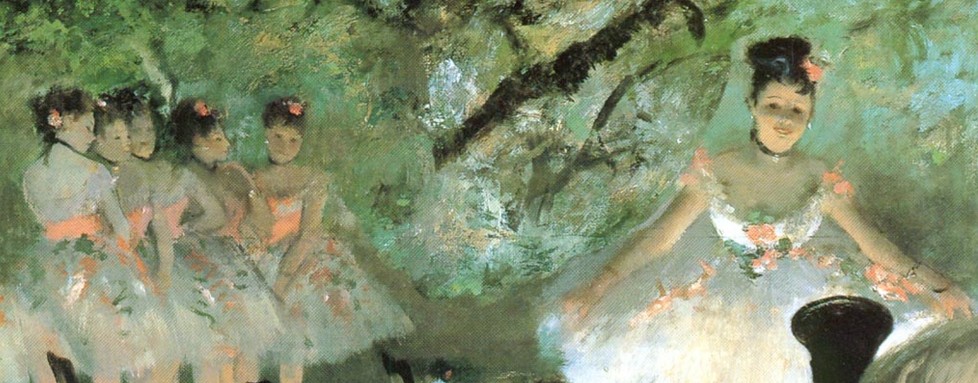Always considered the quintessential painter of dancers, Degas ironically does not appear to be interested in dance. Rarely does he depict a dancer practicing her art (indeed, there is no depiction of the male dancer whatsoever). We see dancers at rest, in the wings, in rehearsal, scratching, fixing her shoe, but rarely dancing. In the few instances we do see a dance movement, it is not an academic pose. The line is the painter’s, not the dancer’s. In fact, his subject is not so much ballet dancers as it is movement, color and the figure in motion. From the perspective of a dancer’s intention, the sculptures of dance positions were the least satisfying in an otherwise gratifying exhibition.
Rather than from dance, Degas’s inspiration comes more from the what the Palais Garnier houses: the culture of theater and the society that animates it. Degas individually characterizes members of the orchestra, the ballet master, the spectators; but the dancers and their male admirers and patrons, who populate the foyer or the wings, he hardly distinguishes as individuals at all, and in that regard, his treatment of the subject resembles more his scenes of brothels and prostitutes. The other regular subjects of Degas, women bathing, women ironing, and in particular jockeys and race horses have more individual identity. And with these other subjects, Degas persists with themes of the figure in movement and of modern culture.

This model in section was on display at the recent exhibition “Degas à l’Opéra” at the Musée d’Orsay.
Adding context to the sketches, pastels, monotypes, sculptures and paintings by Degas, the show’s curators include recordings of operatic voices of the day, the original set design models for the ballet “La Source”, and a spectacular scale model in section of the Palais Garnier which helps clarify how the parts of the Opera’s segmented design relate to each other.
Napoleion III bankrupted the nation to build the opulent Palais Garnier. On the western facade he had built a carriage entrance designated for his use, but he died before he could ever use it. Below the house lies an underground “lake” in case of fire. And there were some, with gas lights and fireplaces in the foyer.
The “grand foyer” dimensions took into account the width of ladies gowns walking in procession. Patrons rented boxes for the season, and each had its own door and lock. The anteroom was used to retreat from the performance and receive guests. The curtained, compartmented box opened onto the auditorium. Only men used to sit in the orchestra seats. Along the edge of the orchestra, a surprisingly high partition with painted sliding screens could be lifted up to provide privacy from the public.
Encircling the grand staircase, storied balconies overlook the fashionable spectacle of arrivals. Often the same performance would play night after night, and Parisian society would gather for an evening of socializing and entertainment. The house lights were always on during a performance. It wasn’t until the scandalous premiere of the play “Ubu Roi” that house lights were dimmed for the first time in a theater. The public whistled in protest because they could not longer see one another; and that was before that historic, avant garde performance caused a riot.
Degas became enamored by the printmaking process of pulling a single image from a plate: the monotype. I went specifically to this exhibition to study Degas monotypes and his layering of pastel on top of his prints.
A charcoal drawing by the author after Degas:

